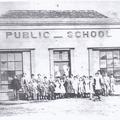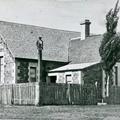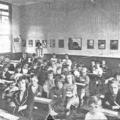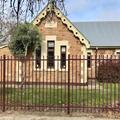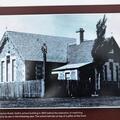< Early Canberra Government Schools
Queanbeyan Public School [1864 - 2017]
Early schooling in Queanbeyan
In the wake of Charles Throsby's explorations in the 1820s, farmers, stockmen and graziers began settling on the best-watered land around the present location of Queanbeyan. One of the first, Timothy Beard, called his station 'Quinbean' which is thought to have been an Aboriginal word for 'clear water'. By the 1860s the small township of Queanbeyan had gradually grown into a service centre for the district, also catering for passers-by taking the Cooma road to the Monaro and Kiandra goldfields.
The first school in Queanbeyan was a Church of England denominational school opened in 1843, in a schoolroom adjoining Christ Church. It had 40 pupils taught by Dr Andrew Morton, a graduate of the Royal College of Surgeons, Edinburgh, who had recently migrated from Scotland via New Zealand to NSW. Morton had taken up the position whilst awaiting a medical appointment locally. Other teachers succeeded him until the school closed in 1871 when its certificate was withdrawn - after the NSW Council of Education found the pupils' progress unsatisfactory.
St Gregory's Catholic School opened in 1852 and continued until 1882, closing in the that year when government aid to denominational schools was withdrawn. Mrs Emily Hutchinson (recently widowed with two young children) opened a private school in 1857, in a rented cottage near the Victoria Hotel. Miss Clarke's school, boarding young ladies, operated briefly 1861-62, in Alfred Cottage near the Queanbeyan River bridge. And Mrs Wainwright's private school operated during the 1880s, in Atkinson Street.
In 1860 Mrs Hutchinson moved her 15 pupils to rented premises in Rutledge Street. Then in 1864 Mrs Agnes Francis opened a private school at Alma Cottage in the same street, probably continuing Mrs Hutchinson's school.
Queanbeyan National School, 1864
On 1st August 1864 Dr Morton and John Gale, editor of a Queanbeyan newspaper, applied to the Board of Education for Agnes Francis's school to be made a non-vested national school. It was stated that the school had already been in operation two months under the charge of Mrs Agnes Francis, with an enrolment of 14 boys and 19 girls. Classes were being conducted in a brick building, 30ft x 15ft in size, at one time the newspaper's printing office.
Inspector McCann, sent to investigate the position, submitted this report to the Board on 9th August: -
1. The school is situated in a central part of the important Town of Queanbeyan.
2. Every religious denomination in the district is represented in the person of a local patron. The patrons are very respectable, have considerable influence in their several spheres of life; are dedicated advocates for the spread of the National System; and have voluntarily proposed the establishment of a school under the Board. They are not only determined to have the proposed non-vested school succeed, but they have moreover initiated steps with a view to erecting a vested school similar to the one at Cooma. Mr Wright will act as Honorary Secretary.
The Patrons were listed as follows: JJ Wright JP, Storekeeper, C.E.; Andrew Morton, Surgeon, Pres.; John Gale, Editor of Queanbeyan Newspaper, Wes.; William Lee, Innkeeper, R.C. The report continued: -
5. The school has only been a short time in operation. Twenty children have already attended. At least 40 pupils are expected. Several who propose boarding in Town, are to come from the bush. There are at least 100 to go to the National School. Many of the parents appear dissatisfied with the arrangements adopted in the denominational schools. The pupils present were clean and orderly, and the course of instruction, is, at present, as national as circumstances will permit ...
7. On the whole, I am of opinion a school is wanted at Queanbeyan, and that a fair one can be established under the auspices of the Board. The only avowed opponent is the Church of England Minister, but then his brother is a Teacher of the denominational school. I have long wished for a good school here, but did not want to press it upon the people. They have, however, voluntarily declared for its establishment, and I cordially recommend their application to the favourable consideration of the Commissioners.
(For all Dept of Educ. references: 'Queanbeyan School', 5/17409-11, NSW Records; also Queanbeyan school history files, courtesy of Brenda McLennan, Dept of Educ, Sydney)
The application was approved and the school began operating as a national school in October 1864, with Mrs Francis as teacher. It had 44 pupils by the end of the year and in January 1865 Miss H. Gootes was appointed assistant teacher. In March, Inspector Harris accompanied by the four local patrons inspected the newly opened school. He found the pupil's attainments 'very satisfactory' and some of their answers 'worthy of honourable mention'. Mrs Francis had commendable zeal and diligence, he reported, but he deplored the school building as being 'totally unfit for the purpose of a school'. In response to this criticism, the local patrons decided to take immediate steps to have a new school and teacher's residence erected on a site selected by the government.
When Mrs Francis resigned later that year due to ill health, there were 68 pupils enrolled. She requested that a married couple with 'first-class credentials' replace her, which the Board undertook to do, appointing Samuel McPhail and his wife as the new teachers in September. The school, meanwhile, was shifted temporarily into better premises in the Oddfellows Hall. In December 1866, Queanbeyan Age reported that Inspector Harris, on visiting the school, had found the children 'acquitting themselves most creditably' and had commended Mr McPhail on his 'unremitting care and exertion' as head teacher.
Queanbeyan Public School, 1866
Under the Public Schools Act of 1866, the NSW Council of Education supplanted the Board of National Education. As this required the formation of local school boards, Queanbeyan School's four patrons were replaced by a school board consisting of Messrs JJ Wright, A Levy, WF Hayley, John Gale, JB Thompson and Dr A Morton.
During 1869, various complaints from influential Queanbeyan citizens were made about Mr McPhail, in particular regarding his drinking habits: Dean White compelled some of the Catholic children to leave the school, the Anglican rector, Rev. Soares publically castigated his teaching capacity, and school board member, Abraham Levy, called him 'a drunken sod' in front of the pupils at school. As a result, McPhail was transferred to Jembaicunbene in December that year, however he failed to alter his drinking habits and was dismissed in 1871 'on account of intemperance'.
Before McPhail's replacement William Holland arrived in January 1870, the school was temporarily relocated into more spacious premises: a vacant store in Monaro Street owned by the school board member JJ Wright. Deciding on a permanent site for a new school had been problematic. Plans were first drawn up in 1868 for a school and residence on a 2 acre town block to be resumed by the government, however further progress lapsed when the local school board could not contribute 1/3 of the cost as required by government regulation. Then after Holland complained about the dilapidated state of his private rooms and the general unsuitability of Wright's store as a school, the government eventually acquired Lot 1, section 21, Parish of Queanbeyan: a 2 acre block bounded by Isabella, Crawford and Booth Streets, and the Queanbeyan River. The site was notified in July 1873 and dedicated on 4th February 1876.
The building tender accepted came from Messrs Helman and Priest who contracted to erect a school house and detached teacher's residence for 1,554 pounds and 7 shillings. The schoolhouse, 58ft x 20ft, had a boys' classroom, girls classroom, infants gallery and two hat rooms; sufficient space for 200 pupils. The walls were to be made of stone and the woodwork, cedar; the teacher's residence to have eight rooms, an attic and spacious front and rear verandahs. The build began without delay and was finally completed in November 1877. As indicated, the community was supposed to have contributed 1/3 of the cost; however when the school board secretary, John Gale, wrote to the Department objecting to this, the payment was waived. Gale had argued that Yass Public School was financed by a government grant of 6000 pounds, with no community contribution.
More challenges for the teacher, Mr Holland
When a speech William Holland made on 7th August 1875 at a centenary of the birth of the Irish hero Daniel O'Connell was reported in the press, some members of the school board took exception to a teacher expressing Irish-Catholic partiality. The board's chairman, James Thompson, called for his resignation, supported by JJ Wright who had been opposed by local Irish when running as a candidate for parliament. When the Council of Education declined to remove Holland, Wright closed the school on grounds that the Council's rental of his building was in arrears. Wright kept the school closed for two weeks, but relented when 32 Protestant parents petitioned their support of Holland and planned to open the school in a tent. This averted the stand off and the school re-opened on 27 September, Holland retaining his position.
The next year, Holland became embroiled in another sectarian related dispute, this time resulting in his leaving the school. In June 1876, school inspector JH Murray received a complaint from James O'Neill, an influential Queanbeyan citizen of Irish-Protestant descent. O'Neill complained that Holland had been earning money from giving Latin lessons on some days after school, when he was required by regulation to be coaching O'Neill's daughter, Isabella, in her teacher-training. O'Neill wanted Holland dismissed and, like Wright a year earlier, exercised his ownership of the school's premises (recently purchased from Wright) by closing the school.
In his defence, Holland wrote to Inspector Murray that O'Neill had a history of causing divisions in the community, compared with his own unblemished record of 18 years' teaching service. He did, however, accept that the Latin lessons had infringed on some of the time he should have been giving to Miss O'Neill's teacher-training (one hour daily after 4 pm by regulation). This admission resulted in him being severely reprimanded, after which it appears he decided to move away from the town. He left Queanbeyan in July 1876 to take up a position at Yass Catholic School where he stayed until 1881. His later career was in public schools at Wagga and Young, before retiring from teaching in 1888.
On Holland's departure, the school was closed for two months until Richard Van Heythusen replaced him on 19th September 1876. The school then re-opened in a schoolroom adjoining Christ Church. Yet another kerfuffle followed when the Anglican rector, Canon Soares, refused to open the building, claiming he hadn't been properly informed about its leasing by the Council. In due course this was sorted out through Bishop Thomas's intervention, classes continuing there until the new school was ready to occupy in November 1877.
Early years in the new school
The new public school was officially opened on 29th November by the Secretary of the Council of Education, William Wilkins. It had 114 pupils and a staff of three: Mr Van Heythusen, pupil-teacher Isabella O'Neill and Mrs Van Heythusen who took sewing lessons as 'work mistress'.
The teaching loads improved a little in 1882 when a new principal, James Buckland, was appointed. By then there were 67 boys and 53 girls taught by a staff of four: Buckland, assistant teacher Matilda MacDonnell, pupil-teacher Jane Eglington, and work mistress Mrs Kelly - Isabella O'Neill having resigned in 1880. James Buckland was in his late 50s when he came to the school, and had requested that his wife be appointed work mistress. Mrs Emily Kelly, however, was considered a more eligible candidate and given the job.
In September 1882 a school concert attended by the community and about 100 pupils was held in the Temperance Hall. John Gale presided over the evening and Mr Buckland endeavoured to demonstrate how much the children's singing and elocution had improved since his arrival. The programme included a round, 'Merrily, Merrily Great the Morn'; 'Sing, Birdie Sing' by the infants department; 'Our Gallant Volunteers' recited by Master Buckland; and 'The Rifle Cadets' by the whole school – given loudest applause. Thanks were extended to the school board chairman, Mr JJ Wright, for generously donating a cricket set to the school, and a hope expressed that many similar entertainments would follow in the future.
(Trove: Queanbeyan Age, 29 Sept. 1882)
There was, however, community concern that Buckland was too infirm to be head teacher. Three months after the concert, JJ Wright sent a petition to this effect to the Board of Public Instruction. Inspector Dawson, asked to report on the matter, concurred, stating that the school's reputation was in decline and that Buckland should be replaced. He was transferred to Pennant Hills Public in February 1883, in an exchange with Reuben Hayter who came to Queanbeyan. Buckland took sick leave and had some medical treatment shortly after arriving at Sydney. He died in November 1885.
Reuben Hayter's firm discipline soon gave rise to some parental complaints. In March 1883 he sent a 14-year-old pupil called Charles Scott home from school to attend next day in cleaner clothes. The same afternoon the father returned with his son to the school, demanding that the boy be returned to class dressed as he was. The ensuing altercation resulted in Inspector Dawson being asked for his report. Dawson found that the boy had actually been expelled for insolence and supported Hayter's restoration of discipline from a decline that had occurred under his predecessor.
Then in November that year, Hayter chastised JJ Wright's son, George, in an offensive manner during a drill lesson. Wright complained to District Inspector Maynard that the headmaster said to George: 'You are jumping about like a monkey. If you want to join the monkeys, get your father to sew a tail onto your backside'. Answering the complaint, Hayter said that his words were in jest, and that he had actually used the word 'back', not 'backside'. The inspector considered it sufficient to caution Hayter not to use such 'injudicious and undignified' language in future.
The next year, Inspector Dawson dealt with yet another parental complaint. This time from William Brook, who said that Mr Hayter had struck his son, William, 'several times violently in the stomach', and had accused William's sister, Sarah, 'of going home and telling falsehoods about the matter'. After questioning a number of pupils including William and Sarah, the inspector considered the complaint unsubstantiated. Mr Brook was informed accordingly and the matter dismissed.
Reuben Hayter left the school in June 1887, transferred to Mortlake Public where he served until 1889. His subsequent career was undistinguished and ended when he was 'called on' to resign in 1907.
(Much of the above and what follows has been valuably informed by John Cope, If only these stones could speak: a history of Queanbeyan Public School, 1864- 2001, Queanbeyan Public School P&C)
The growing school, 1887-1896
The next head teacher, James Dunlop, served nine years at the school, 1887-1896. Dunlop received favourable reports and managed the school competently during a period of steadily growing pupil enrolment. In 1887 the total enrolment was 180 and the average attendance, 120. In August 1887 the Hon. E Sullivan MLA sought an additional classroom at the school, but the Department declined his request on grounds that the accommodation was sufficient for the school numbers.
There was also community interest in having evening classes at the school, which Dunlop supported and offered to teach. He applied formally to commence them in March 1889, listing 16 male students aged 15 to 22 who wished to attend: some apprenticed saddlers, butchers, printers and drapers, a telegraph clerk, postman, ironmonger, wool-scourer and cordial factory worker, and three labourers. Approval was granted and the classes began on 1st May. The number of years they operated, however, is uncertain.
A few months later the teaching staff increased from three to four, by way of an extra pupil-teacher. It then comprised: Dunlop, assistant teacher Mary Cruickshank, and two pupil-teachers, Alice Beatty and Lauristina Carver.
In May 1890 Dunlop applied for the school to be designated Superior, since it had the capacity to educate at least 20 pupils beyond primary, preparing some of them to sit a public examination for university. Dunlop wrote to the Department: -
I have the honour to request that this school may be raised to the rank of a Superior Public.
There are at least 20 pupils in the school who have completed the course prescribed for a 4th class, and there is a 5th class with an average attendance of 12, which has been in existence nearly a year. There will be little difficulty in continuing to maintain a good 5th class, and if this request is granted the task will be rendered comparatively easy.
Several pupils are now being prepared for the next junior university examination, and it is intended to send pupils regularly in future to this and other examinations.
The request was approved and the school gazetted a Superior Public School on 27th June 1890. Shortly after, the requested extra classroom was granted. A tender was accepted from Mr J Jordan to build a semi-detached infants classroom, 25ft x 19ft, at a cost of 345 pounds. It was completed in February 1891. Later that year, additional land was acquired for the growing school: Lots 2, 3 and 4 of section 21, Parish of Queanbeyan - adjoining the existing school site (see map below).
In the first quarter of 1890, there were 153 enrolled, and an average attendance of 133. The teaching staff of five comprised principal teacher Dunlop, assistant teacher Margaret Deasy, temporary assistant Florence Cavanough, and the two pupil- teachers, Alice Beatty and Lauristina Carver. In October 1891 Dunlop requested an extra pupil-teacher, as the average attendance had by then grown to 162. Approval was given and one of older students, Augustus Siebert aged 15, began his training under Dunlop.
By all accounts, Dunlop was a capable, hard-working principal; however the load of teaching 60-70 children in three classes, supervising three pupil-teachers and running the school, would certainly have been demanding and tiring. Little wonder then, that his patience was at times short, his disciplinary language caustic, and corporal punishment occasionally excessive.
In September 1890, for example, Mrs E. Smith complained to the local school board about Dunlop's harsh punishment of her son, John. She provided the board with a medical certificate from Dr Richardson that the boy had bruises on his thigh and back. Brought to Inspector Cooper's attention, Dunlop explained that he had disciplined John for persistent lateness, giving him six strokes on the body with a cane. Cooper's memo to a chief inspector recommended that Dunlop 'be censored as to the necessity for giving strict attention to the Departmental Regulations on the matter of corporal punishment', adding that he relied too much on the cane and satirical speech to secure obedience and order.
There was a similar complaint about Dunlop's discipline in 1895, but they were relatively minor blemishes on his nine years' service at Queanbeyan. In 1892, Inspector Cooper gave him due praise for having raised the school to the school to the Superior grade, and having pupils succeed in the university public examination. He was also credited with founding an excellent school cadet corps and in general maintaining a fine school. Having striven several times for promotion, Dunlop finally gained Level 1 in December 1894. In mid 1896, he was transferred to Kiama and served later at Tamworth and Singleton. His last position was that of headmaster at Croyden Park, from which he retired in 1928.
The school and community, 1896-1913
George Ling took charge of the school in July 1896, transferring from Silverton, near Broken Hill. About 30, he was a younger head teacher, with a more kindly disposition than James Dunlop. During his long term of 17 years at the school, the number of pupils grew only moderately from 173 to 187, while the staff increased by one: from four to five.
Various building improvements during this period made the school more comfortable and workable. In 1898, a long verandah was added to the infants' room and a new, much-needed 400 gallon water tank supplemented the old underground tank. In 1902, the old cess-pit toilets were replaced, the school roof re-shingled and a wash-shed and bathroom added to the teacher's residence, at a total cost of 254 pounds. The next year, further repairs were made to the weather shed and verandahs on the residence.
On 24th May 1905 the school and community celebrated Empire Day (only recently introduced). George Ling addressed the assembled pupils about the history of the British Empire, and then the whole school joined a procession through the town, led by senior boys bearing the Union Jack and Commonwealth flags. A sports day followed in the recreation ground, and at night 300 adults and children enjoyed a bonfire and fireworks in the school playground, concluding with the national anthem and three cheers for the King.
The first mention of a Parents and Citizens' Association at the school appears in 1912, its president being Mr Charles Campbell. On 7th March 1913, Campbell wrote to the Department deploring its decision not to allow the school to close so the children and teachers could attend a ceremony for the Foundation of the Federal Capital. It would deny them the opportunity to witness 'a far-reaching historical event', he wrote. Permission to close the school was quickly granted.
On 31st March 1913 George Ling was farewelled at a gathering in the School of Arts. The chairman, Mr Hungerford, said Mr Ling had been a painstaking teacher whose only fault, perhaps, was that he was too kind to the children. Another speaker said he had never heard a bad word about him and that he had been a fine citizen. He was presented with a travelling rug and umbrella. In mid-year he left Queanbeyan to take up an appointment at Wyong. He died at Sydney in 1938, aged 72.
Expansion under headmaster James Ridley 1913-1930
James Ridley took charge of the school on 19th March 1913, transferring from Gulargambone Public. He was about 45 years of age and soon gained the community's respect as a capable and gentlemanly head teacher.
In 1915 he sought permission to close the school on 30th July to participate in a district fund-raising day in support of soldiers wounded in the First World War. Permission given, the whole school took part in a procession through Queanbeyan followed by sports and displays in the showground, stallholders contributing their proceeds to the cause.
By March 1918 there were 286 pupils enrolled and an average attendance of 257. The building of a new classroom was approved at a cost of ₤562/6/6, the work being undertaken by Messrs Jordan and Patterson. Detached from the main building, the new room was 22ft x 21ft in size, with a full-length verandah.
At the end of 1919, 31 students at the school were awarded the qualifying certificate for secondary education. In 1920, the first secondary students proceeded to the newly introduced Intermediate Certificate. The new classroom barely helped accommodate the school's growing numbers, so in 1924 another room was sought and granted. It was completed in February 1925 at a cost of 1420 pounds. Even then the school was over-crowded. In 1926 a large number of desks were urgently delivered to meet a shortage of seating, the enrolment having nearly doubled in eight years, to 520.
By 1927 the staff had risen to ten: James Ridley and Eileen Kain shared the secondary classes and eight infants to primary teachers had an average of 53 pupils per class. In the same year a double and two single portable classrooms were added to the school. Another double portable was erected in 1929, and for a couple of years the Anglican Church hall was used for school purposes.
On 11th July 1930, James Ridley and his wife Annie (who became one of the staff) were farewelled at a Town Hall function in appreciation of 17 years of dedicated service at the school. Speeches were made and gifts presented, including an illuminated address to James Ridley, which read in part: 'we have learned to esteem your many sterling qualities, which combined with your strong personality and unfailing courtesy, have endeared you to all'. Ridley transferred to Turramurra in Sydney, where he died aged 64 on 28th November 1932 - a year before he was due to retire.
Later changes to the school site
Queanbeyan was graded a District School in 1931 and became an Intermediate High School in 1933. In January 1933 an additional 1 acre, 38 perches of adjacent land was acquired for school purposes by the Lands Department. This extended the school's playing area towards Queanbeyan River, giving better scope to site a new infants' school in 1933 and a large new building for the primary and secondary divisions in 1936. The school reverted to a public school from 1st January 1958 with the opening of Queanbeyan High School, both of which are still operating.
(Contributed by Keith Amos, former teacher at The Mullion, out of Yass)
Location Map
Related Photos
Teachers
- Francis, Mrs Agnes
10/1864 - 06/1865 - McPhail, Mr Samuel
09/1865 - 01/1870 - Holland, Mr William T
01/1870 - 07/1886 - O'Neill, Isabella Ann
Pupil Teacher, 04/1874 - 06/1880 - van Heythusen, Mr Richard
09/1876 - 01/1882 - Buckland, Mr James
01/1882 - 02/1883 - Hayter, Mr Reuben
02/1883 - 06/1887 - Dunlop, Mr James
06/1887 - 07/1896 - Ling, Mr George E A
07/1896 - 03/1913 - Ridley, Mr James
03/1913 - 06/1930 - Martin, Mr George R
06/1930 - 12/1931 - Ransley, Mr Thomas
12/1931 - 12/1932 - Gallagher, Mr Francis J
12/1932 - 06/1937 - Lyons, Mr Laurice
06/1937 - 11/1945 - Madden, Mr John D
11/1945 - 11/1948 - Mason, Mr John D
02/1949 - 01/1952 - Frist, Mr Ernest L
01/1952 - 01/1956 - Gollan, Mr Kenneth G
01/1957 - 01/1958
NSW Government schools from 1848
- Queanbeyan Public School (external link)
< Early Canberra Government Schools
If you are able to assist our work of identifying, documenting, and celebrating the early bush schools of the Canberra region, please contact us or .



